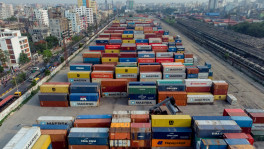Risk weighted asset of 34 banks increased
The Bangladesh Bank has been pressing the banks to maintain CRAR at 12.5 percent as a part of the implementation of Basel III in the banking sector

The total risk weighted asset of 34 banks has increased in the July-September quarter compared to the previous quarter.
The overall Capital to Risk (Weighted) Assets Ratio (CRAR) in the country's banking sector dropped to 11.65 percent as of September 30 last year from 11.74 percent in June.
The CRAR increased to 11.41 percent in March last year from 10.5 percent in December 2018.
The Bangladesh Bank has been pressing the banks to maintain CRAR at 12.5 percent as a part of the implementation of Basel III in the banking sector.
Basel III is an international regulatory accord that introduced a set of reforms designed to improve the regulation, supervision and risk management within the banking sector.
In spite of maintaining capital base, an increase in risk weighted asset is not a good sign for the banking sector, said experts.
The capital base of the banks deteriorated as 12 banks suffered Tk17,658 crore in capital shortfall as of September 30 last year thanks to soaring defaulted loans.
At the end of June, 11 banks suffered Tk16,001.49 crore in capital shortfall.
The 12 banks that faced capital shortfall in the July-September quarter are Sonali, Janata, Agrani, Rupali, BKB, Rakub, BCBL, AB Bank, Basic Bank, ICB Islami Bank, Community Bank and the National Bank of Pakistan.
Community Bank Bangladesh Limited has newly been added in the shortfall list as it started reporting from the September quarter.
A rise in the non-performing loans was the main reason for the weakening of banks' capital base that resulted in capital shortfall, observed experts.
The remaining 46 banks managed to maintain adequate capital against their risk weighted assets maintaining Tk14,246.91 crore in capital surplus.
As per the Bangladesh Bank data, the amount of defaulted loans in the country's banking sector increased by 23.83 percent or Tk22,377 crore in the first nine months of 2019.


 Keep updated, follow The Business Standard's Google news channel
Keep updated, follow The Business Standard's Google news channel
















